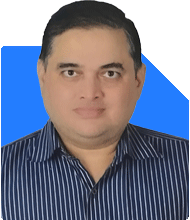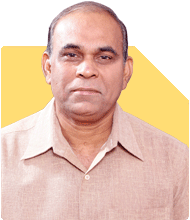32-year-old earning Rs.1 lakh/month: How to reach Rs.10 crore in 15 years?
Ramalingam Kalirajan |10893 Answers |Ask -Follow
Mutual Funds, Financial Planning Expert - Answered on Aug 21, 2024
He has an MBA in finance from the University of Madras and is a certified financial planner.
He is the director and chief financial planner at Holistic Investment, a Chennai-based firm that offers financial planning and wealth management advice.... more

My age is 32 years, I make around 1 lac/month . Monthly expenses- 50000/month including everything Current investments- PF- 6.5 lac, FD 8 lac, PPF-15 lac, Mutual fund- 9 lac - stocks 8 lacs I want to retire in next 15 years with approx 10 crores. Pls suggest me the right strategy?
Setting a Clear Retirement Goal
You want to retire in 15 years with a corpus of Rs 10 crores. This goal is ambitious but achievable with disciplined planning and a robust investment strategy. Given your current financial status, let's evaluate the steps required to reach your target.
Enhancing Your Investment Strategy
To achieve your retirement goal, it is essential to reassess your investment strategy. Here's how you can optimize your portfolio:
1. Increase Your Equity Exposure
Equities have the potential to deliver higher returns over the long term compared to other asset classes. With 15 years until retirement, you have a sufficient investment horizon to benefit from the growth potential of equities.
Mutual Funds: You should consider increasing your investments in mutual funds, especially in actively managed funds. These funds have the potential to outperform index funds due to the expertise of fund managers in selecting high-quality stocks.
Stocks: Continue investing in stocks, but ensure that your portfolio is well-diversified across sectors and companies. This helps in mitigating risks while capitalizing on the growth of various industries.
2. Reassess Fixed Deposits and PPF
While FDs and PPF provide safety, their returns may not be sufficient to meet your ambitious retirement goal. Here's how you can reassess them:
Fixed Deposits: FD returns are generally lower compared to equity-based investments. You might consider gradually shifting some of your FD investments to mutual funds to enhance potential returns.
PPF: PPF is a good tax-saving instrument, but its returns are moderate. Continue with your PPF contributions, but consider diverting some new contributions towards higher-yielding investments.
3. Focus on Systematic Investment Planning (SIP)
Systematic Investment Planning (SIP) in mutual funds is a disciplined approach to wealth creation. It allows you to invest regularly and benefit from rupee cost averaging.
Increase SIP Contributions: With a monthly saving potential of Rs 50,000, you should aim to increase your SIP contributions. Investing in a mix of large-cap, mid-cap, and small-cap funds could provide a balanced approach to growth and risk management.
4. Diversification and Risk Management
A well-diversified portfolio spreads risk across various asset classes and investment vehicles. This approach is essential to protect your investments from market volatility.
Asset Allocation: You should aim for an asset allocation that balances risk and returns. Given your retirement goal, a higher allocation to equities could be beneficial, but ensure that you maintain some exposure to safer assets like debt funds or bonds.
5. Regular Portfolio Review
The financial markets and your personal situation may change over time. Regularly reviewing your portfolio is crucial to ensure that it remains aligned with your goals.
Annual Review: Conduct an annual review of your portfolio to assess its performance and make necessary adjustments. This helps in staying on track towards your retirement goal.
Building a Robust Emergency Fund
An emergency fund is crucial to handle unexpected financial situations without disrupting your investment plan. Given your income and expenses, an emergency fund of Rs 6-8 lakhs would be appropriate.
Liquid Funds: Consider parking this amount in liquid funds, which provide easy access and better returns than a savings account.
Tax Efficiency
Maximizing tax efficiency is vital to enhance your overall returns. Consider the following strategies:
Tax-Saving Mutual Funds: Invest in tax-saving mutual funds (ELSS) to avail of tax deductions under Section 80C. This also helps in building your equity portfolio.
Optimize PPF Contributions: Continue contributing to your PPF account to avail of tax benefits and secure a portion of your portfolio in a low-risk instrument.
Estate Planning and Insurance
Ensuring that your family is financially secure in your absence is paramount. You should have adequate life insurance and a proper estate plan in place.
Term Insurance: Ensure that you have a term insurance plan with a sum assured that covers your family's future expenses and financial goals.
Will and Nomination: Draft a will and ensure that all your investments have the correct nominations to avoid legal complications for your heirs.
Final Insights
Achieving a retirement corpus of Rs 10 crores in 15 years is a challenging yet attainable goal. It requires a well-thought-out strategy, disciplined investing, and regular monitoring of your financial plan. By enhancing your equity exposure, optimizing your current investments, and focusing on tax efficiency, you can align your financial plan with your retirement goals. Regular reviews and adjustments will ensure that your strategy remains on track, providing you with financial security and peace of mind.
Best Regards,
K. Ramalingam, MBA, CFP,
Chief Financial Planner,
www.holisticinvestment.in
You may like to see similar questions and answers below
Ramalingam Kalirajan |10893 Answers |Ask -Follow
Mutual Funds, Financial Planning Expert - Answered on Jul 25, 2024
Milind Vadjikar | Answer |Ask -Follow
Insurance, Stocks, MF, PF Expert - Answered on Nov 02, 2024
Ramalingam Kalirajan |10893 Answers |Ask -Follow
Mutual Funds, Financial Planning Expert - Answered on Feb 04, 2025
Ramalingam Kalirajan |10893 Answers |Ask -Follow
Mutual Funds, Financial Planning Expert - Answered on Jul 30, 2025
Ramalingam Kalirajan |10893 Answers |Ask -Follow
Mutual Funds, Financial Planning Expert - Answered on Aug 21, 2025
Ramalingam Kalirajan |10893 Answers |Ask -Follow
Mutual Funds, Financial Planning Expert - Answered on Dec 15, 2025
Ramalingam Kalirajan |10893 Answers |Ask -Follow
Mutual Funds, Financial Planning Expert - Answered on Dec 15, 2025
Radheshyam Zanwar |6746 Answers |Ask -Follow
MHT-CET, IIT-JEE, NEET-UG Expert - Answered on Dec 15, 2025
Ramalingam Kalirajan |10893 Answers |Ask -Follow
Mutual Funds, Financial Planning Expert - Answered on Dec 15, 2025
Ramalingam Kalirajan |10893 Answers |Ask -Follow
Mutual Funds, Financial Planning Expert - Answered on Dec 15, 2025
Ramalingam Kalirajan |10893 Answers |Ask -Follow
Mutual Funds, Financial Planning Expert - Answered on Dec 15, 2025
Samraat Jadhav |2508 Answers |Ask -Follow
Stock Market Expert - Answered on Dec 15, 2025
Ramalingam Kalirajan |10893 Answers |Ask -Follow
Mutual Funds, Financial Planning Expert - Answered on Dec 15, 2025
Reetika Sharma |425 Answers |Ask -Follow
Financial Planner, MF and Insurance Expert - Answered on Dec 15, 2025
Radheshyam Zanwar |6746 Answers |Ask -Follow
MHT-CET, IIT-JEE, NEET-UG Expert - Answered on Dec 15, 2025

























